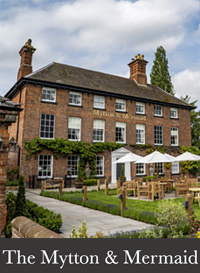


Local Sponsors
-
The Mytton & Mermaid
Atcham, Shrewsbury Shropshire SY5 6QG
Built originally as a private house on the banks of the River Severn, which may have dated from as early as 1725, commissioned by Richard Hill of Tern Hall (which would later become Attingham Hall, a stunning National Trust property open to visitors that sits opposite us) and believed to have been called ‘the Dower House’. Since then it has had many names, the Talbot Arms, the Berwick Arms before settling on the unusual Mytton and Mermaid in the 1930's after being purchased by the famous architect Sir Clough Williams Ellis, who developed the Italianate village of Portmeirion in North Wales. Sir Clough converted the building to a hotel and chose the name Mytton after a local character ‘Mad Jack Mytton’ a gentleman who squandered his fortune in the most spectacular way, and the Mermaid came from the crest of the Portmeirion hotel. The building is surrounded by beautiful patios and sits on the banks of the river, so plenty of places to sit and enjoy the sunshine (when we are blessed with it), we have a Private Dining Room that seats up to 18, perfect for family gatherings and small meetings and we have 10 bedrooms if you’d like to stay with us overnight.
-
Wales and South West
Canal and River Trust. Llanthony Warehouse, The Docks, Gloucester, GL1 2EH
The Canal and River Trust's historic canals and rivers provide a local haven for people and nature. We're the new charity entrusted with the care of 2,000 miles of waterways in England and Wales.
-
The Severn Rivers Trust
Unit 3, Hope House Farm Barns, Hope House Lane, Martley. WR6 6QF
An independent environmental charity established to secure the preservation, protection, development and improvement of the rivers, streams, watercourses and water bodies in the Severn catchment.
-
Unlocking the Severn - Canal and River Trust
Diglis Island, Diglis Dock Road, Worcester, WR5 3BS
Unlocking the Severn is a once-in-a-lifetime conservation and river-engagement project. Restoring connectivity on the River Severn will bring major benefits to its wildlife.Restoring 158 miles of river for shad. The project is inspired by one of the UK’s rarest fish. Hundreds of thousands of twaite shad used to migrate up the River Severn to reach their natural spawning grounds. But weirs installed in the mid-19th century blocked this annual migration. Unlocking the Severn will provide fish passage at six barriers on the River Severn and its River Teme tributary. This will restore 158 miles of river habitat and benefit a host of other important fish species including salmon and eel. The Canal and River Trust (lead), Severn Rivers Trust, Environment Agency and Natural England are the partner organizations for delivering this project. Unlocking the Severn is funded by the Heritage Lottery Fund and the EU LIFE Programme, as well as The Waterloo Foundation and the partners.





